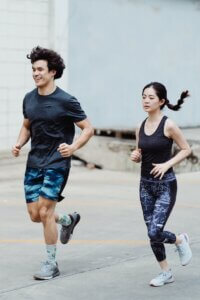Are you curious if running with a sweatshirt can actually help you burn more calories? You’re not alone! Many fitness enthusiasts have wondered about the potential benefits of this unconventional approach to running.
Picture yourself hitting the pavement, clad in your favorite sweatshirt, as you power through your workout. But does this seemingly simple choice of attire have any real impact on your calorie burn or overall performance?
In this blog post, we’re diving into the world of running with a sweatshirt to uncover the truth. Get ready to discover the science behind it, explore its pros and cons, and find out if it’s the right fit for your fitness goals. Let’s lace up and unravel this intriguing phenomenon!
Table of Contents
Does Running with a Sweatshirt Burn More Calories?

Absolutely! Running with a sweatshirt can indeed help you burn more calories during your workouts. When you exercise, your body naturally burns calories to fuel your muscles and keep you moving. But by wearing a sweatshirt while running, you can increase your calorie expenditure even further.
Let’s break it down with some numbers. Studies suggest that wearing a sweatshirt during physical activity can lead to an additional calorie burn of around 5-15%.
For example, if you typically burn 300 calories during a 30-minute run without a sweatshirt, wearing one could potentially increase your calorie burn to 315-345 calories.
How does this work?
Well, wearing a sweatshirt creates a slightly warmer microclimate around your body. As a result, your body needs to work harder to cool itself down, which means you burn more calories. It’s like giving your metabolism a little extra boost!
To put it into perspective, imagine running on a hot summer day. When it’s scorching outside, you may notice that you sweat more and feel like your body is working harder.
Wearing a sweatshirt replicates that effect to some extent, even if the temperature isn’t as high. So, by increasing your body’s heat production, you’re essentially ramping up your calorie burn.
So, if you’re looking to maximize your calorie burn during your runs, give running with a sweatshirt a try. Just make sure to choose a sweatshirt that fits well, allows for proper ventilation, and doesn’t impede your movements.
Does running with a sweatshirt increase intensity?
Absolutely! Running with a sweatshirt can indeed increase the intensity of your workout. Studies have shown that wearing a sweatshirt during exercise can elevate your heart rate and make your body work harder.
Think about it this way: when you wear a sweatshirt, your body has to work extra to regulate its temperature. The added layer traps heat and increases your body’s effort to cool down. As a result, your heart pumps more blood, and your muscles work harder, leading to an intensified workout.
Example
Imagine running on a cool day without a sweatshirt. Your body temperature remains stable, and your workout may feel relatively comfortable. Now, imagine running the same distance with a sweatshirt on. Your body warms up faster, causing your heart rate to rise, and you’ll likely feel more fatigued.
So, if you’re looking to challenge yourself and take your runs up a notch, try adding a sweatshirt to your workout attire.
Read: Is running with a backpack good?
Are There Benefits to Wearing A Hoodie While Exercising?

Absolutely! Wearing a hoodie while exercising can offer several benefits that enhance your workout experience. Let’s dive into some of the advantages you can enjoy:
1. Retains Body Heat for Warmth and Comfort
When you put on a hoodie, especially in colder weather or during outdoor workouts, it acts as an extra layer to help retain your body heat. This added warmth can make your workout more comfortable, allowing you to focus on your performance rather than feeling chilly.
2. Enhances Sweat Absorption
Hoodies are often made from materials like cotton or moisture-wicking fabrics, which can effectively absorb sweat during exercise. As you work up a sweat, the hoodie helps to keep you dry by absorbing the moisture away from your body.
This feature can be particularly useful during high-intensity workouts or when exercising in hot and humid conditions. Imagine wearing a hoodie while pushing through an intense cardio session at the gym, feeling dry and comfortable even as you sweat.
3. Provides Protection from the Elements
Whether you’re running outdoors or engaging in outdoor sports, a hoodie offers an extra layer of protection against wind, light rain, or even harmful UV rays.
The hoodie can shield your head and ears from chilly winds, while the long sleeves can provide some protection from light rain or sunburn.
4. Promotes a Sense of Privacy and Focus
Wearing a hoodie can create a cocoon-like effect, providing a sense of privacy and focus during your workout. The hoodie can help create a visual barrier between yourself and the surroundings, minimizing distractions and allowing you to concentrate on your movements and goals.
This can be especially beneficial if you prefer a more introspective workout or if you find crowded gym environments overwhelming.
So, if you’re looking for an extra layer of warmth, sweat absorption, protection from the elements, or a way to enhance your focus during workouts, give wearing a hoodie a try. It might just become your new favorite workout companion!
Does Running with a Sweatshirt Have Any Drawbacks?
Yes, running with a sweatshirt can have some drawbacks. While it may seem like a great idea to wear a sweatshirt during your run, it’s important to consider a few factors that could affect your overall experience and performance. Let’s take a closer look at these potential drawbacks:
1. Overheating
When you exercise, your body temperature rises naturally. Wearing a sweatshirt can further increase your body heat, leading to excessive sweating and potentially overheating.
This can make your run uncomfortable and may even cause fatigue or dizziness. It’s crucial to listen to your body and be aware of any signs of overheating.
2. Restricted Movement
Sweatshirts, especially if they are loose or not the right size, can limit your range of motion. Imagine trying to swing your arms freely while running with sleeves that are too long or a hoodie that obstructs your peripheral vision.
Restricted movement can affect your running form and efficiency, potentially leading to discomfort or even injuries.
3. Breathability Issues
Sweatshirts are often made of thick materials that may not offer adequate breathability. As a result, moisture can get trapped against your skin, making you feel sweaty and damp.
Without proper ventilation, your body may struggle to cool down efficiently, which can contribute to discomfort during your run.
4. Weight and Drag
A sweatshirt can add extra weight to your body, which might affect your overall running performance. Additionally, the loose fabric can create drag against the wind, making it slightly harder for you to maintain your usual pace.
While these effects may not be significant, they are worth considering if you’re aiming for peak performance.
Read: Running with a weighted vest
Factors to Consider When Running with a Sweatshirt

When it comes to running with a sweatshirt, there are a few important factors to keep in mind to ensure a comfortable and effective workout. Let’s dive right into them:
👉🏻 Fit and Fabric Matters
Finding the right fit and fabric for your sweatshirt is crucial. Opt for a sweatshirt that allows for unrestricted movement and isn’t too tight or too loose. Look for moisture-wicking fabrics like polyester or blends with spandex to keep you dry and comfortable throughout your run.
These fabrics are designed to pull sweat away from your body, preventing that heavy, wet feeling.
👉🏻 Consider the Weather Conditions
The weather plays a significant role in choosing the right sweatshirt for your run. In cooler temperatures, a lightweight sweatshirt with long sleeves can provide the necessary warmth and insulation.
However, if it’s hot and humid outside, wearing a sweatshirt may lead to overheating and excessive sweating. In such cases, you might opt for a lighter, breathable layer or consider running without a sweatshirt.
👉🏻 Layering for Versatility
Layering is an excellent strategy when running with a sweatshirt, as it allows you to adapt to changing weather conditions or your body’s temperature fluctuations. Start with a moisture-wicking base layer, such as a technical t-shirt, to help manage sweat.
Then, add your sweatshirt as a mid-layer for insulation. If it gets too warm, you can easily remove the sweatshirt and tie it around your waist.
👉🏻 Safety First: Consider Visibility
When running outdoors, especially in low-light conditions, it’s crucial to consider visibility. Look for sweatshirts with reflective elements or bright colors to enhance your visibility to drivers and other pedestrians. Additionally, consider wearing reflective accessories such as armbands or a headlamp for added safety.
By keeping these factors in mind – fit and fabric, weather conditions, layering, and visibility – you can make an informed decision when choosing a sweatshirt for your running sessions.
Is Running With a Sweatshirt Safe?
Running with a sweatshirt can help increase sweat and calorie burn but may also lead to overheating and dehydration.
It’s beneficial for weight loss in cooler weather, yet risky in hot conditions or for those with heart issues. Safety depends on the individual’s health, hydration levels, and environmental conditions.
Read: Running with tennis shoes
What Type of Sweatshirt is Best for Running?
When it comes to choosing the right sweatshirt for running, there are a few key features to look for. Let’s dive in and find out what makes a sweatshirt ideal for your running sessions.
✅ Opt for Moisture-Wicking Fabrics
Look for sweatshirts made from moisture-wicking materials such as polyester blends or technical fabrics.
These fabrics are designed to pull sweat away from your body, keeping you dry and comfortable during your run. They also help regulate your body temperature, preventing overheating.
✅ Seek Breathability
A breathable sweatshirt allows air to circulate, keeping you cool while preventing excessive sweat buildup.
Look for sweatshirts with ventilation panels or mesh inserts in areas like the back, underarms, or sides. These features promote airflow and enhance breathability.
✅ Consider Lightweight and Stretchy Materials
A lightweight sweatshirt made from stretchy materials offers optimal freedom of movement. You don’t want your sweatshirt to restrict your arms or torso while running. Look for materials that allow for a natural range of motion and won’t weigh you down.
✅ Reflective Details for Safety
If you often run in low-light conditions, a sweatshirt with reflective details can enhance your visibility to others, such as drivers or cyclists. Reflective strips or logos can make a big difference in ensuring your safety during early morning or evening runs.
✅ Pay Attention to Fit
The right fit is crucial for a comfortable and effective running experience. Opt for a sweatshirt that is slightly loose or has a relaxed fit, allowing for layering if needed. Avoid overly tight sweatshirts that can restrict your movement or cause discomfort during your run.
Remember, the best sweatshirt for running will vary depending on personal preferences and weather conditions. Consider factors like the climate you’ll be running in, the length of your runs, and the level of intensity.
Now that you know what to look for, go ahead and find that perfect sweatshirt that will elevate your running experience to the next level!
Final Thoughts
When it comes to running with a sweatshirt, the decision ultimately rests on your personal preferences and goals. While some believe it can boost calorie burn and intensity, others may find it uncomfortable or restrictive.
Remember, safety should always be a priority, and it’s important to listen to your body’s cues. If you choose to run with a sweatshirt, consider factors like fabric, fit, and weather conditions to ensure a comfortable and enjoyable experience.
Whether you’re looking for an added challenge or simply seeking a cozy workout option, experimenting with a sweatshirt might be worth a try. Embrace what works best for you and keep pushing towards your fitness goals, one stride at a time.
Frequently Asked Questions
Why do athletes wear hoodies when running?
Athletes wear hoodies to stay warm and increase sweat, helping in muscle flexibility and possible weight loss. Yet, it’s vital not to overheat, especially in warm conditions.
Is it OK to workout in a hoodie?
Working out in a hoodie is fine for warming up and sweating more, but watch out for overheating and dehydration. If you feel too hot, take it off.
Is it good to run with a sweat suit?
A sweat suit ups your sweat, which might seem good for losing weight. However, it risks dehydration and heat exhaustion, especially in the heat. Use caution, stay hydrated, and don’t overdo it.


